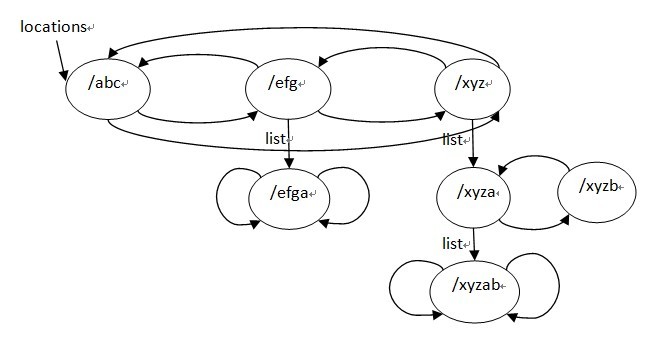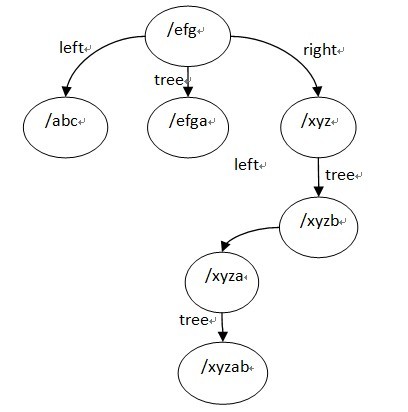nginx location的管理以及查找
关于nginx代码解析,我师兄雕梁的博客(http://simohayha.javaeye.com)有一系列的文章可以阅读。我这里将只介绍他博客里没有关注到的或者讲述不详细的,但是我个人又认为是nginx里面比较重要的东西。在这一篇文章里,我将介绍nginx关于location的处理,大家都知道Nginx配置文件里面会有很多的location,nginx的配置指令的作用域可以分为 main,server,location这3个种,实际上这3者不是依次包含的关系,而是相互独立的关系,比如一个只具有main级别作用域的指令,是不能写在某个server或者location内的,模块的某个指令可以同时具有main,server,location这3种作用域,另外每个模块有 main,srv,loc这3个级别的配置,一个模块的main级别的配置对所有的server和location都是共享的,srv级别的配置对所有 location都是共享的,location只有自己独立的loc级别的配置,这就是为什么一个模块的srv和loc级别的配置需要merge,而 main级别的配置不需要merge的原因。这里看起来有点绕,区分一下main,server,location分别作为一种作用域级别和一个主体,类似于形容词和名字的区别,nginx的配置关系还是不难理解的。
一般来说一个请求url过来,nginx会将它解析到某一个location来处理。这个解析的过程实际上根据location的配置基本可以分为字符串匹配和正则表达式匹配这2种。对于location的组织方式,最简单的就是直接将它们保存为一个链表,解析url的时候一个一个遍历即可找到相应location,但是这样效率太低,对像nginx这种高性能的服务器来说是完全不可取的,nginx将字符串匹配的location组织成了一个三叉的字符串排序树,而且建立的时候也考虑了树的平衡性。文章后面我讲详细介绍源码的实现。
首先我来大概的介绍一下location的种类和匹配规则,以nginx wiki(http://wiki.nginx.org/HttpCoreModule#location)的例子做说明:
- location = / {
- # matches the query / only.
- [ configuration A ]
- }
- location / {
- # matches any query, since all queries begin with /, but regular
- # expressions and any longer conventional blocks will be
- # matched first.
- [ configuration B ]
- }
- location ^~ /images/ {
- # matches any query beginning with /images/ and halts searching,
- # so regular expressions will not be checked.
- [ configuration C ]
- }
- location ~* \.(gif|jpg|jpeg)$ {
- # matches any request ending in gif, jpg, or jpeg. However, all
- # requests to the /images/ directory will be handled by
- # Configuration C.
- [ configuration D ]
- }
- location @named {
- # Such locations are not used during normal processing of requests,
- # they are intended only to process internally redirected requests (for example error_page, try_files).
- [ configuration E ]
- }
可以看到上面的例子中有5种不同类型的location,其中第4个带 “~” 号前缀的为需要正则匹配的location,nginx在进行url解析时对这5种不同类型的location具有不同的优先级规则,大致的规则如下:
1,字符串精确匹配到一个带 “=” 号前缀的location,则停止,且使用这个location的配置;
2,字符串匹配剩下的非正则和非特殊location,如果匹配到某个带 "^~" 前缀的location,则停止;
3,正则匹配,匹配顺序为location在配置文件中出现的顺序。如果匹配到某个正则location,则停止,并使用这个location的配置;否则,使用步骤2中得到的具有最大字符串匹配的location配置。
例如,对下面的请求有:
1, / -> 精确匹配到第1个location,匹配停止,使用configuration A
2,/some/other/url -> 首先前缀部分字符串匹配到了第2个location,然后进行正则匹配,显然没有匹配上,则使用第2个location的配置configurationB
3,/images /1.jpg -> 首先前缀部分字符串匹配到了第2个location,但是接着对第3个location也前缀匹配上了,而且这时已经是配置文件里面对这个url的最大字符串匹配了,并且location带有 "^~" 前缀,则不再进行正则匹配,最终使用configuration C
4,/some/other/path/to/1.jpg -> 首先前缀部分同样字符串匹配到了第2个location,然后进行正则匹配,这时正则匹配成功,则使用congifuration D
nginx的url匹配规则实际上有点不妥,大部分情况下一个url必须先进行字符串匹配,然后再做正则匹配,但是实际上如果先做正则匹配,没有匹配上再 做字符串匹配,在很多情况下可以节省掉做字符串匹配的时间。不管怎样,先来看一下nginx源码里面的实现,在介绍匹配location过程之前,先来介 绍一下nginx里面对location的组织方式,实际上在配置解析阶段,nginx将字符串匹配的location和正则匹配的location分别 存储在http core模块的loc配置ngx_http_core_loc_conf_t结构的下面2个字段:
- ngx_http_location_tree_node_t *static_locations;
- (NGX_PCRE)
- ngx_http_core_loc_conf_t **regex_locations;
- if
从这2个字段的类型可以看出,字符串匹配的location被组织成了一个location tree,而正则匹配的location只是一个数组,location tree和regex_locations数组建立过程在ngx_http_block中:
- /* create location trees */
- for (s = 0; s < cmcf->servers.nelts; s++) {
- clcf = cscfp[s]->ctx->loc_conf[ngx_http_core_module.ctx_index];
- if (ngx_http_init_locations(cf, cscfp[s], clcf) != NGX_OK) {
- return NGX_CONF_ERROR;
- }
- if (ngx_http_init_static_location_trees(cf, clcf) != NGX_OK) {
- return NGX_CONF_ERROR;
- }
- }
经过配置的读取之后,所有server都被保存在http core模块的main配置中的servers数组中,而每个server里面的location都被按配置中出现的顺序保存在http core模块的loc配置的locations队列中,上面的代码中先对每个server的location进行排序和分类处理,这一步发生在 ngx_http_init_location()函数中:
- static ngx_int_t
- ngx_http_init_locations(ngx_conf_t *cf, ngx_http_core_srv_conf_t *cscf,
- ngx_http_core_loc_conf_t *pclcf)
- {
- ...
- locations = pclcf->locations;
- ...
- /* 按照类型排序location,排序完后的队列: (exact_match 或 inclusive) (排序好的,如果某个exact_match名字和inclusive location相同,exact_match排在前面)
- | regex(未排序)| named(排序好的) | noname(未排序)*/
- ngx_queue_sort(locations, ngx_http_cmp_locations);
- named = NULL;
- n = 0;
- #if (NGX_PCRE)
- regex = NULL;
- r = 0;
- #endif
- for (q = ngx_queue_head(locations);
- q != ngx_queue_sentinel(locations);
- q = ngx_queue_next(q))
- {
- lq = (ngx_http_location_queue_t *) q;
- clcf = lq->exact ? lq->exact : lq->inclusive;
- /* 由于可能存在nested location,也就是location里面嵌套的location,这里需要递归的处理一下当前location下面的nested location */
- if (ngx_http_init_locations(cf, NULL, clcf) != NGX_OK) {
- return NGX_ERROR;
- }
- #if (NGX_PCRE)
- if (clcf->regex) {
- r++;
- if (regex == NULL) {
- regex = q;
- }
- continue;
- }
- #endif
- if (clcf->named) {
- n++;
- if (named == NULL) {
- named = q;
- }
- continue;
- }
- if (clcf->noname) {
- break;
- }
- }
- if (q != ngx_queue_sentinel(locations)) {
- ngx_queue_split(locations, q, &tail);
- }
- /* 如果有named location,将它们保存在所属server的named_locations数组中 */
- if (named) {
- clcfp = ngx_palloc(cf->pool,
- (n + 1) * sizeof(ngx_http_core_loc_conf_t **));
- if (clcfp == NULL) {
- return NGX_ERROR;
- }
- cscf->named_locations = clcfp;
- for (q = named;
- q != ngx_queue_sentinel(locations);
- q = ngx_queue_next(q))
- {
- lq = (ngx_http_location_queue_t *) q;
- *(clcfp++) = lq->exact;
- }
- *clcfp = NULL;
- ngx_queue_split(locations, named, &tail);
- }
- #if (NGX_PCRE)
- /* 如果有正则匹配location,将它们保存在所属server的http core模块的loc配置的regex_locations 数组中,
- 这里和named location保存位置不同的原因是由于named location只能存在server里面,而regex location可以作为nested location */
- if (regex) {
- clcfp = ngx_palloc(cf->pool,
- (r + 1) * sizeof(ngx_http_core_loc_conf_t **));
- if (clcfp == NULL) {
- return NGX_ERROR;
- }
- pclcf->regex_locations = clcfp;
- for (q = regex;
- q != ngx_queue_sentinel(locations);
- q = ngx_queue_next(q))
- {
- lq = (ngx_http_location_queue_t *) q;
- *(clcfp++) = lq->exact;
- }
- *clcfp = NULL;
- ngx_queue_split(locations, regex, &tail);
- }
- #endif
- return NGX_OK;
- }
上面的步骤将正则匹配的location保存好了,location tree的建立在ngx_http_init_static_location_trees中进行:
- static ngx_int_t
- ngx_http_init_static_location_trees(ngx_conf_t *cf,
- ngx_http_core_loc_conf_t *pclcf)
- {
- ngx_queue_t *q, *locations;
- ngx_http_core_loc_conf_t *clcf;
- ngx_http_location_queue_t *lq;
- locations = pclcf->locations;
- if (locations == NULL) {
- return NGX_OK;
- }
- if (ngx_queue_empty(locations)) {
- return NGX_OK;
- }
- /* 这里也是由于nested location,需要递归一下 */
- for (q = ngx_queue_head(locations);
- q != ngx_queue_sentinel(locations);
- q = ngx_queue_next(q))
- {
- lq = (ngx_http_location_queue_t *) q;
- clcf = lq->exact ? lq->exact : lq->inclusive;
- if (ngx_http_init_static_location_trees(cf, clcf) != NGX_OK) {
- return NGX_ERROR;
- }
- }
- /* join队列中名字相同的inclusive和exact类型location,也就是如果某个exact_match的location名字和普通字符串匹配的location名字相同的话,
- 就将它们合到一个节点中,分别保存在节点的exact和inclusive下,这一步的目的实际是去重,为后面的建立排序树做准备 */
- if (ngx_http_join_exact_locations(cf, locations) != NGX_OK) {
- return NGX_ERROR;
- }
- /* 递归每个location节点,得到当前节点的名字为其前缀的location的列表,保存在当前节点的list字段下 */
- ngx_http_create_locations_list(locations, ngx_queue_head(locations));
- /* 递归建立location三叉排序树 */
- pclcf->static_locations = ngx_http_create_locations_tree(cf, locations, 0);
- if (pclcf->static_locations == NULL) {
- return NGX_ERROR;
- }
- return NGX_OK;
- }
经过ngx_http_init_location()函数处理之后,locations队列已经是排好序的了,建立三叉树的过程的主要工作都在ngx_http_create_locations_list()和ngx_http_create_locations_tree()中完成,这2个 函数都是递归函数,第1个函数递归locations队列中的每个节点,得到以当前节点的名字为前缀的location,并保存在当前节点的list字段 下,例如,对下列location:
- location /xyz {
- }
- location = /xyz {
- }
- location /xyza {
- }
- location /xyzab {
- }
- location /xyzb {
- }
- location /abc {
- }
- location /efg {
- }
- location /efgaa {
- }
排序的结果为/abc /efg /efgaa =/xyz /xyz /xyza /xyzab /xyzb,去重后结果为 /abc /efg /efgaa /xyz /xyza /xyzab/xyzb,ngx_http_create_locations_list()执行后的结果为:

最后,来看下ngx_http_create_locations_tree函数:
- static ngx_http_location_tree_node_t *
- ngx_http_create_locations_tree(ngx_conf_t *cf, ngx_queue_t *locations,
- size_t prefix)
- {
- ...
- /* 根节点为locations队列的中间节点 */
- q = ngx_queue_middle(locations);
- lq = (ngx_http_location_queue_t *) q;
- len = lq->name->len - prefix;
- node = ngx_palloc(cf->pool,
- offsetof(ngx_http_location_tree_node_t, name) + len);
- if (node == NULL) {
- return NULL;
- }
- node->left = NULL;
- node->right = NULL;
- node->tree = NULL;
- node->exact = lq->exact;
- node->inclusive = lq->inclusive;
- node->auto_redirect = (u_char) ((lq->exact && lq->exact->auto_redirect)
- || (lq->inclusive && lq->inclusive->auto_redirect));
- node->len = (u_char) len;
- ngx_memcpy(node->name, &lq->name->data[prefix], len);
- /* 从中间节点开始断开 */
- ngx_queue_split(locations, q, &tail);
- if (ngx_queue_empty(locations)) {
- /*
- * ngx_queue_split() insures that if left part is empty,
- * then right one is empty too
- */
- goto inclusive;
- }
- /* 从locations左半部分得到左子树 */
- node->left = ngx_http_create_locations_tree(cf, locations, prefix);
- if (node->left == NULL) {
- return NULL;
- }
- ngx_queue_remove(q);
- if (ngx_queue_empty(&tail)) {
- goto inclusive;
- }
- /* 从locations右半部分得到右子树 */
- node->right = ngx_http_create_locations_tree(cf, &tail, prefix);
- if (node->right == NULL) {
- return NULL;
- }
- inclusive:
- if (ngx_queue_empty(&lq->list)) {
- return node;
- }
- /* 从list队列得到tree子树 */
- node->tree = ngx_http_create_locations_tree(cf, &lq->list, prefix + len);
- if (node->tree == NULL) {
- return NULL;
- }
- return node;
- }
location tree节点的ngx_http_location_tree_node_s结构:
- struct ngx_http_location_tree_node_s {
- ngx_http_location_tree_node_t *left;
- ngx_http_location_tree_node_t *right;
- ngx_http_location_tree_node_t *tree;
- ngx_http_core_loc_conf_t *exact;
- ngx_http_core_loc_conf_t *inclusive;
- u_char auto_redirect;
- u_char len;
- u_char name[1];
- };
location tree结构用到的是left,right,tree 这3个字段, location tree实际上是一个三叉的字符串排序树,而且这里如果某个节点只考虑左,右子树,它是一颗平衡树,它的建立过程有点类似于一颗平衡排序二叉树的建立过程,先排序再用二分查找找到的节点顺序插入,ngx_http_location_tree_node_s的tree节点也是一颗平衡排序树,它是用该节点由ngx_http_create_locations_list()得到的list建立的,也就是该节点的名字是它的tree子树里面的所有节点名字的前缀,所以tree子树里面的所有节点的名字不用保存公共前缀,而且查找的时候,如果是转向tree节点的话,也是不需要再比较父节点的那段字符串了。
ngx_http_create_locations_tree()函数写的很清晰,它有一个参数是队列locations,它返回一颗三叉树,根节点为locations的中间节点,其左子树为locations队列的左半部分建立的location tree,右子树为location队列的右半部分建立的tree,tree节点为该根节点的list队列建立的tree。
最终建立的location tree如下(为了方便阅读,图中列出了tree节点的完整名字):

location的匹配发生在nginx请求处理的NGX_HTTP_FIND_CONFIG_PHASE阶段(请求的处理所有PHASE可以看这篇博客http://simohayha.iteye.com/blog/670326),匹配的规则文章前面已经做过介绍,源码的实现也很简单,这里不再做介绍了。
from:http://blog.csdn.net/fengmo_q/article/details/6683377
nginx location的管理以及查找的更多相关文章
- Nginx location相关配置说明
Nginx location相关配置说明 基于不同的IP.不同的端口以及不用得域名实现不同的虚拟主机,依赖于核心模块ngx_http_core_module实现. 新建PC web站点 [ ...
- Nginx location 匹配顺序整理
Nginx location模块整理 具体的Nginx安装就不在这里描述了,这里只是为了对location的描述 Nginx环境 a. 查看当前系统cat /etc/redhat-release [r ...
- nginx slab内存管理
本来这一篇作为nginx系列的开头是不合适的,不过由于nginx进程框架自己的梳理还没完成,这部分又刚好整理完了,就从这开始吧.这儿谈的是nginx的slab的内存管理方式,这种方式的内存管理在ngi ...
- nginx location 语法
location 语法location 有”定位”的意思, 根据Uri来进行不同的定位.在虚拟主机的配置中,是必不可少的,location可以把网站的不同部分,定位到不同的处理方式上.比如, 碰到.p ...
- Nginx location模块整理
location模块 Nginx location location 指令的作用是根据用户请求的URI来执行不同的应用,URI就是根据用户请求到的网址URL进行匹配,匹配成功了进行相关的操作. loc ...
- 附001.Nginx location语法规则
一 location规则 1.1 location语法 基本语法: location [=|~|~*|^~]/uri/{...} 修饰符释义: 1 = #表示精确严格匹配,只有请求的url路径与后面的 ...
- Nginx Location配置总结
Nginx Location配置总结 语法规则: location [=|~|~*|^~] /uri/ { - }= 开头表示精确匹配^~ 开头表示uri以某个常规字符串开头,理解为匹配 url路径即 ...
- nginx location配置
nginx location配置 location在nginx中起着重要作用,对nginx接收到的请求字符串进行处理,如地址定向.数据缓存.应答控制.代理转发等location语法location ...
- nginx location的配置
文章转自:http://www.ttlsa.com/nginx/nginx-location-configure/ location的语法配置规则: 语法规则: location [=|~|~*|^~ ...
随机推荐
- c++基础五个题(三)
一.一个对象访问普通函数和虚函数的时候,哪一个更快? 访问普通函数更快,因为普通成员函数在编译阶段已经被确定,因此在访问时直接调用对应地址的函数,而虚函数在调用时,需要首先在虚函数表中查找虚函数所在的 ...
- Android应用开发中Intent的作用及使用方法
Intent是一种运行时绑定(run-time binding)机制,它能在程序运行过程中连接两个不同的组件.通过Intent,你的程序可以向Android表达某种请求或者意愿,Android会根据意 ...
- Win32 API中的user32.dll中的ShowWindow方法参数整理
在使用ShowWindow方法来设置窗体的状态时,由于不知道参数值,用起来非常容易混乱,所以整理了以下其参数的枚举值,方便以后的的使用. public class User32API { #reg ...
- Java 学习 第五篇;面向对象
1:基本数据类型的拆装: 基本变量类型 通过 new WrapperClass(primitive) 创建包装类对象: 包装类的对象 通过 WrapperInstance.XXXValue() 获取包 ...
- Effective Java实作类别 - 就是爱Java
定义好了Interface之后,现在我们开始来实作类别:Role,建立一个class,implements Role,将3个属性及clone()实作出来,单纯的getter与setter,可以利用ID ...
- 【其他】IT公司的企业文化与竞争力
一直觉得三流企业靠成本竞争,二流企业靠体制竞争,一流企业靠文化竞争. 企业在竞争时候,总会提到一个词:核心竞争力.对于IT企业来说,核心竞争是什么?无论是技术也好,销售也罢,归根到底还是人才的竞争,优 ...
- UESTC_秋实大哥下棋 2015 UESTC Training for Data Structures<Problem I>
I - 秋实大哥下棋 Time Limit: 3000/1000MS (Java/Others) Memory Limit: 65535/65535KB (Java/Others) Submi ...
- yum安装配置mongoDB客户端和服务器端
1,Centos6.X yum安装mongoDB客户端和服务器端; yum -y install mongodb mongodb-server; 基于epel repo.当前的mongoDB的版本为2 ...
- 【转】使用 udev 高效、动态地管理 Linux 设备文件
简介: 本文以通俗的方法阐述 udev 及相关术语的概念.udev 的配置文件和规则文件,然后以 Red Hat Enterprise Server 为平台演示一些管理设备文件和查询设备信息的实例.本 ...
- PHP MySQL 连接数据库 之 Connect
连接到一个 MySQL 数据库 在您能够访问并处理数据库中的数据之前,您必须创建到达数据库的连接. 在 PHP 中,这个任务通过 mysql_connect() 函数完成. 语法 mysql_conn ...
